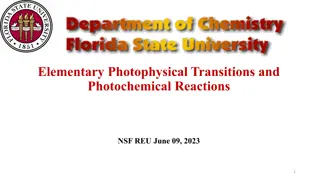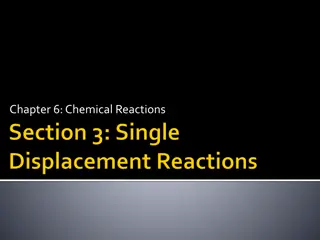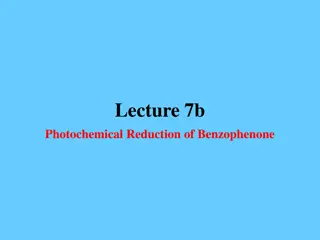Understanding Photochemical Reactions in Chemistry
Photochemistry is the study of chemical effects produced by light radiation. It involves different types of chemical reactions such as photochemical and thermal reactions, each influenced by various factors like light, temperature, and catalysts. This article explores the differences between thermochemical and photochemical reactions, the behavior of light in homogeneous mediums, and the relationship between light intensity and medium thickness. Understanding these concepts is essential in comprehending the fascinating realm of photochemical reactions in chemistry.
Download Presentation

Please find below an Image/Link to download the presentation.
The content on the website is provided AS IS for your information and personal use only. It may not be sold, licensed, or shared on other websites without obtaining consent from the author. Download presentation by click this link. If you encounter any issues during the download, it is possible that the publisher has removed the file from their server.
E N D
Presentation Transcript
Dr.M.K.Valand, Assistant Professor, Chemistry Department, V.P.& R.P.T.P. Science College, Vallabh Vidyanagar
Photochemistry is the study of chemical effects produced by light radiations ranging from 2000 to 8000 A wave- length. Types of chemical reactions: A chemical reaction is one in which, the identity of molecules is changed due to molecules is changed due to the breaking and formation of chemical bonds. There are two types of chemical reactions. (i) Dark or thermal reactions: Reactions which are influenced by temperature, concentration of reactants, catalysts etc.except light radiations are known as thermal reactions.e.g. N2+3H2 2NH3, H2+ I2 2HI. (ii) Photochemical reactions: Reactions which are influenced by the action of light are known as photochemical reactions. Some examples are : 2HBr H2+ Br2(dissociation) , fumericacid Maleic acid (Rearrangement) , H2+ Cl2 2HCl (combination), 2O3 3O2(decomposition).
Thermochemical reactions Photochemical reactions 1 It involves absorption or evolution of heat. 1 It involves absorption of light. 2 It can occur in dark as well as in light. 2 Presence of light is must. 3 Temperature has significant effect on the rate of reaction. These reactions are always accompanied by decrease in free energy. Activation energy is obtained by intermolecular collisions. Thermal excitation increases in random manner.i.e. translational,rotational and vibrational energy of all the molecules increases. 3 Temperature has very little effect on the rate of reaction. In these reactions free energy may increase or decrease. Activation energy is obtained by particular type of radiations. By selecting particular type of radiation particular atom or molecule can be excited along the mixture. 4 4 5 5 6 6
When light is incident upon a homogeneous medium, a part of the incident light is reflected, a part is absorbed and the rest is transmitted. Io = Ia+ It+ Ir -------------- (1) where I0 incident light, Ia absorbed light and Ir reflected light. Iris very small, so equation (1) becomes Io = Ia+ It ----------------- (2)
When a beam of light is allowed to pass through a transparent medium, the rate of decrease of intensity with the thickness of medium is directly proportional to the intensity of light. dI/dt I or dI/dt = I ------------------- (3) Where I is the intensity of incident light of wave length , t is proportionality constant. Upon integration of equation (3) and putting I = Iowhen t = 0, ln (Io/ It) = kt , so (Io/ It) = ektand It= Io. e kt where Iois the intensity of incident light, Itis the intensity of the transmitted light and k is a constant depends upon the wave length and medium used. equation (4) can be changed to common logarithms, It= Io.10 0.4343kt= Io.10 Kt where K = k / 2.3026 ----------------- (6) K is the absorption co-efficient and it is defined as : It is the reciprocal of the thickness which is required to reduce the light to 1/ 10 of its intensity. The ratio It/Iois known as transmittance T. log( Io/It) is known as absorbance A. Io/It is known as opacity. ------------ (4) ----------------- (5)
Lamberts law gives relationship between the transmittance and length of the path. Beer s law gives relationship between transmittance and concentration of the solution. The intensity of a beam of monochromatic light decreases exponentially with the increase in concentration of the absorbing substance arithmetically. It= Io. e k c= Io.10 0.4343k c= Io.10 K c,where k and K are constants and c is the concentration of the absorbing substance. Now, It= Io.10 KtSo we can say, It= Io.10 a.c.tand log( Io/It) = a.c.t --------- ----- (1) where a is constant. is equation (1) is a mathematical statement of Beer- Lambert law. The value of a depends on the units of concentration. If c is in mole dm 3and t in cm, then a is replaced by and is known as the molar absorption coefficient or molar absorptivity. A = log( Io/It) = . c. t = log(1/T) = logT A = . c. t ,Therefore, = A/ c t If c = 1 mole dm 3and t = 1 cm then = A. Thus, molar absorption coefficient is the specific absorption coefficient for a concentration of 1 mole dm 3and a path length of 1 cm. When there are number of absorbing substances , each of these contributes to the rate of absorption of light , A = 1. c1. t + 2. c2. t + = i. ci. t
Absorbance is an extensive property and absorptivity is intensive property. If there is a change in concentration and in the thickness of the container, the value of molar absorptivity will remain constant but the absorbance will change. The value of molar absorptivity will be different at different wave lengths. Therefore a monochromatic radiation is used in spectrometry and colorimetry. Similarly absorbance also varies with wave length.
When Beers law is obeyed by a solution, it means there are no interactions between molecules of the solution and no new types of molecules will be formed as the concentration is changed
If we plot absorbance against concentration, a straight line passing through the origin should be obtained. But there is a deviation from this linear relationship. Deviations are positive if the curve is concave upwards and negative if the curve is concave downwards. Deviation from Beer s law is due to following factors: (i) Beer s law will hold over a wide range of concentration provided the structure of the colored ion or of the colored non- electrolyte in the dissolved state does not change with concentration. If a colored solution is having some other substance whose ions do not react chemically with colored components, its small concentration does not affect the light absorption. Its large concentration may affect light absorption and may also change the molar absorptivity. (ii) Deviation may also occur if the colored solute ionizes, dissociates or associates in solution. For example, benzyl alcohol in chloroform exists in polymeric equilibrium: 4 C6H5CH2OH (C6H5CH2OH)4
Dissociation of the polymer increases with dilution.The monomer absorbs at 2.0 to 2.765 whereas the polymer absorbs at 3.000 .Thus, at 2.050 shows negative deviation and 3.000 shows positive deviation. Another example is the change of color of dichromate ion on dilution. Cr2O7 2 + H2O 2HCrO4 2H+ + CrO4 2 yellow orange The absorption at 450 is positive and 350 it is negative. (iii) Deviations may also occur due to the presence of impurities that fluoresce or absorb at the absorption wave length. (iv) Deviations may occur if monochromatic light is not used. (v) If the width of the slit is not proper, undesirable radiations fall on the detector and deviations may occur. These undesirable radiations may be absorbed by the impurities and the absorbance of the sample will change. (vi) Beer s law cannot be applied to suspensions.
Beers-Lamberts law is used to determine unknown concentration by comparison with a solution of known concentration by using colorimeter or spectrophotometer.
(1) Grotthuss-Draper law: This law is known as first law of photochemistry. When light falls on any substance, only the fraction of incident light which is absorbed by the substance can bring about a chemical change, reflected and transmitted light do not produce any such effect. All light radiations absorbed by reacting system may not used to give desired product. When conditions are not favorable, some portion or the whole light absorbed is converted into heat or re-emitted as radiations. This law is purely qualitative. It does not give any relationship between the amount of light absorbed by a system and the number of molecules reacted. (2) Law of photochemical equivalence: According to quantum theory of light, energy is absorbed or emitted only in small packets of quanta of magnitude E = h v. E is energy, h is Plank s constant , v is the frequency. Einstein applied quantum theory to photochemical reactions and gave the law. When an atom or molecule absorbs light of a given frequency, it absorbs one quantum only.
Einstein considered the work of scientist Stark and restated his law as Each molecule which takes part in a chemical reaction absorbs one quantum of light which induces the reaction. or one molecules one quantum. AB + hv AB* In the primary process, the number of molecules activated is equal to the number of quanta absorbed. Therefore, amount of energy E, for activation of one mole is N.h.v. N is the Avogadro s number. E = N.h.v. This quantity of energy E absorbed per mole is known as Einstein. N = 6.023 x 1023 molecules, h = 6.624 x 10 27 erg. sec E = N.h.v = 6.023 x 1023 x 6.624 x 10 27 x v ergs (1 cal = 4.186 x 107 ergs). Therefore, E = 9.53 x 10 11 v cal. Now, c = .v. Therefore, v = c/ = (3 x1010/ ). So, E = (9.53 x10 11 x 3 x1010/ x10 8) cal. Now,1 A = 10 8 cm, E = ( 2.859 x108/ ) cal = ( 2.859 x105/ ) K cal. It is clear from this equation that energy absorbed per mole decreases with increasing wave length. E 1/ .
A photochemical reaction involves two processes. One is primary process in which light is absorbed by molecule to give excited molecule. Another is secondary process. In this process excited molecule initiates a series of thermal reactions. In such reactions many reactant molecules may undergo chemical change by absorbing one quantum only. In some cases, activated molecule undergoes activation. Thus, less than one molecule may react per quantum. The overall result of photochemical reaction is expressed in terms of quantum yield. The quantum yield or quantum efficiency ( ) is defined as: It is the number of molecules which undergo chemical transformation per quantum of absorbed energy. Mathematically,
= No. of molecules reacting in a given time No. of quanta absorbed in the same time = No. of moles reacting in a given time No. of einsteins absorbed in the same time = Rate of chemical reaction No. of einsteins absorbed The number of quanta absorbed ( a) in a unit time : a = Q / hv .The rate of chemical reaction is (dn/dt) = Q/ hv. The quantum yields are dependent on the light intensity.
Class I: High quantum yield reactions: reactions in which quantum yield is greater than unity are high quantum yield reactions. Some examples are: The quantum yield of the combination of carbon monoxide and chlorine by a light of wave length from 4000 to 4360 A is 103. CO + Cl2 COCl2. The quantum yield of the combination hydrogen and chlorine by a light of wave length less than 4500 A is 104 to 106. H2 + Cl2 2HCl.Photochemical decomposition of H2O2 by a wave length of about 3100 A has quantum yield more than 7. 2H2O2 2H2O + O2. Class II: Low quantum yield reactions: reactions in which quantum yield is less than unity are low quantum yield reactions. Some examples are: The quantum yield of the combination hydrogen and bromine to form HBr is nearly 0.01. H2 + Br2 2 HBr. The quantum yield of photolysis of ammonia by a wave length 2100A HBr is nearly 0.2. 2NH3 N2 + 3H2 . The quantum yield of the dissociation of acetone to form CO and ethane by a light of wave length 3000 A is 0.1.CH3COCH3 CO + C2H6. The quantum yield of the rearrangement reaction of maleic acid to fumaric acid by a light of wave length from 2000 to 1800 A is 0.04.
Class III: Small integer quantum yield reactions: Reactions in which quantum yield is a small integer like 1,2,3, are small integer quantum yield reactions. The quantum yield of the dissociation of HI by a light of wave length 2070 to 2823 A is 2. 2HI H2 + I2. The quantum yield of the following reaction is 1. 2Fe +3 + I2 Fe+2 + 2I . This reaction is carried out in liquid phase by a wave length 5790 A. The quantum yield of the combination of SO2 and Cl2 by a light of wave length 4200 A is 1. SO2 + Cl2 SO2Cl2. The quantum yield of the ozonisation of oxygen by a light of wave length 1700 to 1900 A is 3. 3 O2 2 O3.























